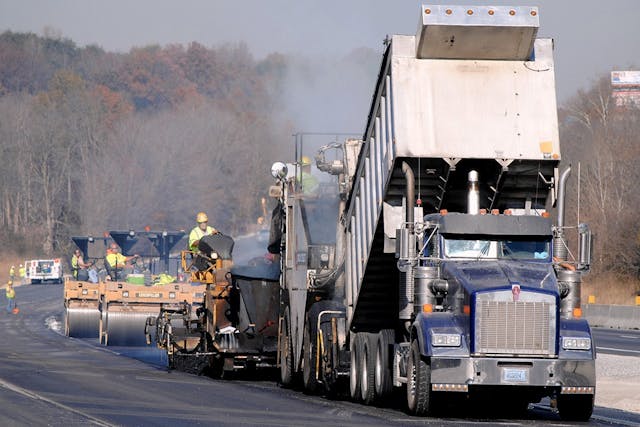Change Your Residential or commercial property's Landscape with Hot Mix Asphalt Paving Excellence
Change Your Residential or commercial property's Landscape with Hot Mix Asphalt Paving Excellence
Blog Article
Opening the Keys of Warm Mix Asphalt Modern Technology
Discovering the midsts of hot mix asphalt technology reveals a world where careful processes and precise solutions merge to shape our roads and facilities. The fusion of fillers, binders, and aggregates isn't merely a construction task yet a tactical orchestration of longevity and effectiveness.
Importance of Warm Mix Asphalt
Warm Mix Asphalt plays a critical function in modern-day facilities development due to its longevity and cost-effectiveness. As the most generally utilized leading material for roads, freeways, and auto parking lots, Warm Mix Asphalt offers a variety of advantages that add to its significance in building and construction projects. One crucial benefit is its capability to hold up against rush hour lots and severe weather condition problems, providing a resilient and trusted surface for transportation networks. Furthermore, Warm Mix Asphalt is cost-effective in both initial building and long-lasting upkeep, making it a preferred choice for lots of framework tasks.
The toughness of Hot Mix Asphalt stems from its make-up, which includes aggregates, binder, and filler materials that are meticulously chosen and blended to satisfy specific efficiency demands. Overall, the value of Hot Mix Asphalt in infrastructure advancement can not be understated, as it proceeds to be a cornerstone of modern-day construction techniques.
Components of Asphalt Mixes
The structure of asphalt blends is composed of very carefully chosen aggregates, binder, and filler products that are important for attaining details performance requirements. Aggregates are the key component of asphalt blends, giving strength and security. The binder, commonly asphalt or asphalt concrete, holds the aggregates together and provides flexibility and toughness to the mix.
The combination and proportion of these elements play a considerable function in figuring out the top quality and efficiency of the asphalt mix. Designers very carefully make the mix to fulfill specific requirements, considering factors like traffic volume, environment problems, and sidewalk life expectancy. Appropriate selection and balancing of aggregates, binder, and fillers are vital for producing resilient, long-lasting asphalt sidewalks.
Combining and Manufacturing Methods

Once the aggregates are chosen, the binder, usually asphalt concrete, is included in bind the products with each other. The binder's top quality and amount considerably influence the mix's resistance, stamina, and versatility to environmental variables. Additionally, fillers like hydrated lime or Rose city concrete may be integrated to improve specific characteristics of the asphalt mix, such as her response its workability or dampness resistance.
Throughout production, the accumulations and binder are heated, generally in between 250-325 ° F(121-163 ° C ), to promote blending and guarantee proper coating of the accumulations. The mixing process has to be detailed to achieve an uniform blend that promotes the wanted efficiency qualities of the asphalt. Numerous methods, such as batch blending or drum mixing, are used to accomplish high-quality and constant asphalt mixes for construction jobs.
Factors Influencing Asphalt Performance
Aspects influencing asphalt performance include an array of variables that impact the sturdiness, long life, and general quality of asphalt pavements. One essential aspect is the top quality of materials utilized in the asphalt mix.

Design considerations, such as pavement thickness and drain, are crucial in ensuring the long-term performance of the asphalt pavement. By thoroughly thinking about these aspects, designers and specialists can enhance asphalt efficiency and boost the solution life of sidewalks.
Sustainable Practices in Asphalt Technology
:max_bytes(150000):strip_icc()/asphalt-worker-134249388-58cdf96f5f9b581d723f2f33.jpg)
WMA enables for the manufacturing and placement of asphalt blends at lower temperature levels compared to standard hot-mix asphalt, resulting in reduced power intake and greenhouse gas discharges. The usage of porous asphalt mixes can aid mitigate stormwater drainage issues by enabling water to penetrate through the sidewalk and into the ground, promoting all-natural water purification and recharge procedures.
Verdict
To conclude, hot mix asphalt technology plays a critical duty in modern infrastructure development because of its toughness and cost-effectiveness. By thoroughly balancing components, employing appropriate mixing techniques, and thinking about different elements, engineers can produce premium asphalt blends that stand up to rush hour tons and extreme climate condition. Accepting sustainable practices, such as using recycled products and warm-mix innovations, even more enhances the environmental kindness of asphalt modern technology.
Blending and production techniques in warm mix asphalt innovation involve the precise mix and handling of aggregates, binder, and fillers to create a sturdy and high-performance asphalt mix.Aspects influencing asphalt performance incorporate a variety of variables that affect the sturdiness, durability, and general quality of asphalt pavements. Sustainable methods in asphalt technology incorporate various initiatives intended at decreasing the environmental influence of asphalt production and paving procedures. By incorporating redeemed asphalt pavement (RAP) and recycled asphalt tiles (RAS) into brand-new asphalt mixes, the sector can substantially decrease the intake of raw materials and energy, while likewise decreasing garbage dump waste.
WMA allows for the production and positioning of asphalt mixes at reduced temperatures compared to traditional hot-mix asphalt, resulting in minimized power consumption weblink and greenhouse gas exhausts.
Report this page